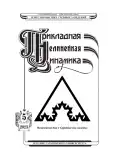Classification of brain activity using synolitic networks
- Authors: Vlasenko D.V.1, Zaikin A.A.2, Zakharov D.G.3,4,5
-
Affiliations:
- Saint Petersburg State University
- University College London
- National Research University "
- Higher School of Economics"
- Issue: Vol 31, No 5 (2023)
- Pages: 661-669
- Section: Articles
- URL: https://journals.rcsi.science/0869-6632/article/view/251297
- DOI: https://doi.org/10.18500/0869-6632-003062
- EDN: https://elibrary.ru/RUEQPM
- ID: 251297
Cite item
Full Text
Abstract
About the authors
Daniil Vladimirovich Vlasenko
Saint Petersburg State University
ORCID iD: 0009-0002-4867-2896
7/9 Universitetskaya Emb., 199034 , Saint Petersburg , Russia
Aleksei Anatolevich Zaikin
University College London
ORCID iD: 0000-0001-7540-1130
ResearcherId: K-6581-2017
University College London, Gower Street, London, UK
Denis Gennadevich Zakharov
National Research University "Higher School of Economics"
ORCID iD: 0000-0003-4367-8965
SPIN-code: 8021-2904
Scopus Author ID: 26435617000
ResearcherId: Q-1962-2015
ul. Myasnitskaya 20, Moscow, 101000, Russia
References
- Ogawa S, Lee TM, Kay AR, Tank DW. Brain magnetic resonance imaging with contrast dependent on blood oxygenation. Proceedings of the National Academy of Sciences of the United States of America. 1990;87(24):9868–9872. doi: 10.1073/pnas.87.24.9868.
- Singleton MJ. Functional magnetic resonance imaging. Yale J. Biol. Med. 2009;82(4):233.
- Gao JS, Huth AG, Lescroart MD, Gallant JL. Pycortex: an interactive surface visualizer for fMRI. Frontiers in Neuroinformatics. 2015;9:23. doi: 10.3389/fninf.2015.00023.
- Li X, Dvornek NC, Zhou Y, Zhuang J, Ventola P, Duncan JS. Graph neural network for interpreting task-fMRI biomarkers. In: Shen D, Liu T, Peters TM, Staib LH, Essert C, Zhou S, Yap PT, Khan A, editors. Medical Image Computing and Computer Assisted Intervention – MICCAI 2019. MICCAI 2019. Vol. 11678 of Lecture Notes in Computer Science. Cham: Springer; 2019. P. 485–493. doi: 10.1007/978-3-030-32254-0_54.
- Saueressig C, Berkley A, Munbodh R, Singh R. A joint graph and image convolution network for automatic brain tumor segmentation. In: Crimi A, Bakas S, editors. Brainlesion: Glioma, Multiple Sclerosis, Stroke and Traumatic Brain Injuries. BrainLes 2021. Vol. 12962 of Lecture Notes in Computer Science. Cham: Springer; 2022. P. 356–365. doi: 10.1007/978-3-031-08999-2_30.
- Anderson A, Cohen MS. Decreased small-world functional network connectivity and clustering across resting state networks in schizophrenia: an fMRI classification tutorial. Frontiers in Human Neuroscience. 2013;7:520. doi: 10.3389/fnhum.2013.00520.
- Kim BH, Ye JC. Understanding graph isomorphism network for rs-fMRI functional connectivity analysis. Frontiers in Neuroscience. 2020;14:630. doi: 10.3389/fnins.2020.00630.
- Nazarenko T, Whitwell HJ, Blyuss O, Zaikin A. Parenclitic and synolytic networks revisited. Frontiers in Genetics. 2021;12:733783. doi: 10.3389/fgene.2021.733783.
- Horikawa T, Kamitani Y. Generic Object Decoding (fMRI on ImageNet) [Electronic resource]. OpenNeuro. 2019. No. ds001246. doi: 10.18112/openneuro.ds001246.v1.2.1.
- Pedregosa F, Varoquaux G, Gramfort A, Michel V, Thirion B, Grisel O, Blondel M, Prettenhofer P, Weiss R, Dubourg V, Vanderplas J, Passos A, Cournapeau D, Brucher M, Perrot M, Duchesnay E. ´ Scikit-learn: Machine learning in Python. Journal of Machine Learning Research. 2011;12(85): 2825–2830.
Supplementary files










